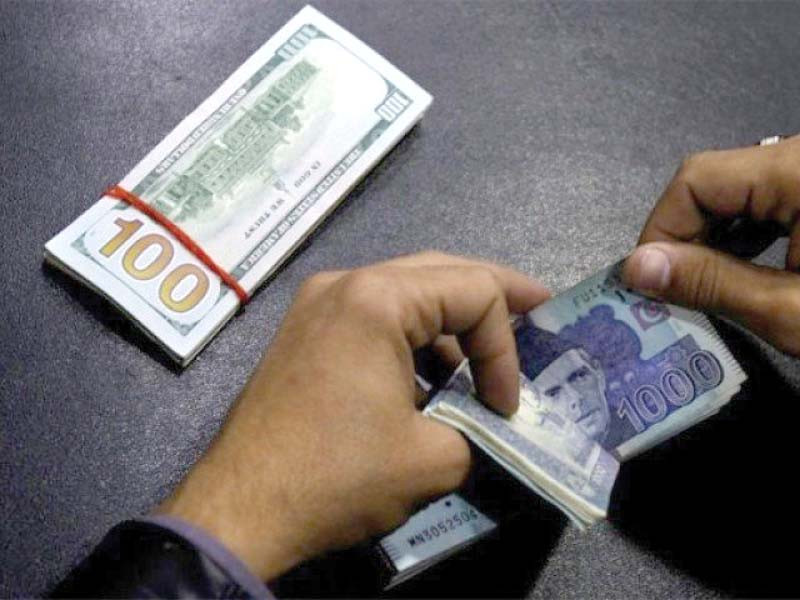
Pakistani currency came under renewed pressure, as it suddenly depreciated 0.5% (around Re1) to a two-week low at Rs186.63 against the US dollar on Friday as no meaningful progress had been made in acquiring fresh bailout packages from the friendly countries.
The rupee was seen consolidating around Rs185-186 before Eid holidays on expectations that Prime Minister Shehbaz Sharif and Finance Minister Miftah Ismail would succeed in acquiring bailout packages from the friendly countries, including Saudi Arabia and the United Arab Emirates (UAE) during their visit to the two countries.
“Rupee has faced renewed pressure due to lack of progress following media reports about the government acquiring fresh bailout packages from friendly countries,” BMA Capital Deputy Head of Research Abdul Rehman said while talking to The Express Tribune.
The country’s foreign exchange reserves have continued to deplete fast. They have dropped by around $7 billion (around 40%) over the past four months to $10.5 billion in late April 2022.
“Foreign currency inflows are the need of the hour to support the rupee against the greenback,” Rehman said, adding “on the contrary, we are seeing net outflows for the past several months.”
The reserves hit an all-time high at $20.14 billion in August 2021, according to the central bank’s data.
Earlier, a domestic media outlet reported that Pakistan had convinced Saudi Arabia to extend a bailout package of $8 billion, including the rollover of $3 billion which the kingdom deposited in the State Bank of Pakistan’s (SBP) account during the tenure of the previous PTI government (August 2018-April 2022).
“The domestic currency is anticipated to move between Rs185 and Rs190 against the US dollar till the government succeeds in bringing new inflows from the friendly countries and the International Monetary Fund,” Rehman said.
He voiced hope that the ambiguity about inflows from the bilateral and multilateral sources would become clear over the next 10 days.
The real effective exchange rate (REER) – the value of domestic currency against a basket of currencies of trading partners – suggests that the rupee is hovering around its fair value (at 97 on the index) at present.
“The rupee will recover to settle around Rs180 against the US dollar in the medium run after the government manages to fetch new inflows,” he said.
He added that the government would acquire new packages from the bilateral partners in phases.
Like in the first phase, the government would convince Saudi Arabia to roll over its old deposits worth $3 billion in the SBP account.
“Later, the kingdom is expected to enhance deposits and double the amount of credit line for oil supplies on deferred payment to $2.4 billion a year from $1.2 billion a year at present,” he said.
The disbursement of the IMF’s next tranche (of around $1 billion) of the loan package of $6 billion and inflows from friendly countries would go side-by-side and coincide instead one follows the other, he said.
The IMF team is scheduled to visit Pakistan in a few days to complete its sixth review of the domestic economy under its (on-hold) $6 billion loan programme.
The approval of the sixth review would allow the IMF to disburse the next tranche of the loan by the end of May 2022, he said.
The rupee has also come under (renewed) pressure due to a rebound in the international crude oil prices to over $110 a barrel.
Pakistan heavily relies on imported energy to meet the domestic demand. The imports make up around 70% of the overall energy requirements in the country.
“The hike in global oil prices stands negative for Pakistan,” Arif Habib Limited (AHL) Head of Research Tahir Abbas said.
The latest trade data suggests that Pakistan oil import bill has continued to rise due to persistent increase in the global energy prices. Otherwise, the non-energy import bill has reduced over the past two months (Feb-Mar).
The share of energy imports stands at 25% in US denomination, out of total imports in Pakistan in the first nine months (Jul-Mar) of the current fiscal year 2021-22.
Published in The Express Tribune, May 7th, 2022.
Like Business on Facebook, follow @TribuneBiz on Twitter to stay informed and join in the conversation.


















COMMENTS (4)
Comments are moderated and generally will be posted if they are on-topic and not abusive.
For more information, please see our Comments FAQ